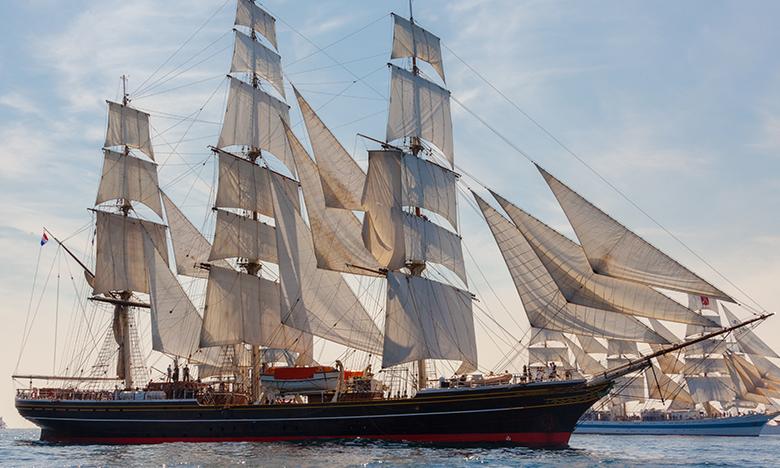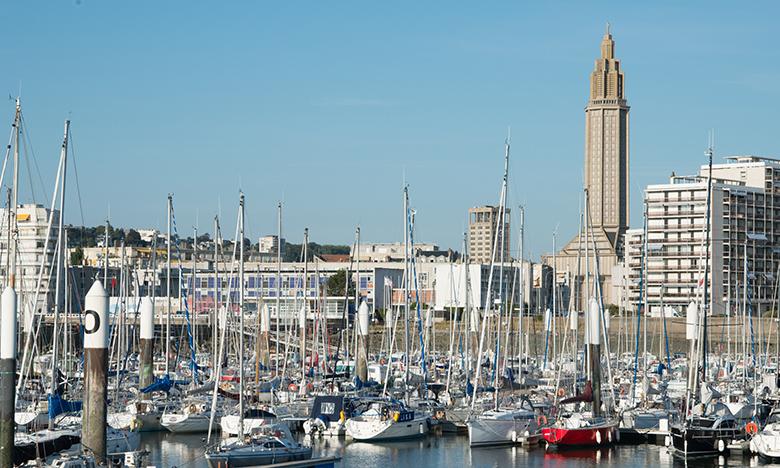For more information, visit the Le Havre Tourism Office at www.lehavretourisme.com.
City region: Normandy
Population & what they are called: 172,807 inhabitants (2014 census), called Havrais
Access from Paris:
by road: about 2 h 15 min (125 miles) via the A13 autoroute de Normandie
by train: about 2 h 5 min by intercity service from the Gare Saint Lazare
Famous native daughters & sons:
Jean Dubuffet, artist
Raymond Queneau, poet and novelist
govy, artist
Most distinctive and/or unique fact or trait (or little known fact):
- The high standard and historical importance of Auguste Perret’s post-war reconstruction architecture in the city center of Le Havre was recognized as a UNESCO World Heritage Site.
Notable sites:
Eglise Saint-Joseph – 12,768 pieces of glass set in an octagonal tower light up this modern church to dramatic effect
Maison de l'Armateur – the 18th-century, relic-filled mansion of the architect in charge of constructing Le Havre's fortifications and fountains
Appartement Témoin – a historic show apartment to help understand how architects and designers aimed to rehouse the locals after 80% of the city was destroyed in World War II
Top annual events:
moZ’aïque – a world music festival with performers from Le Have and around the world (mozaique.lehavre.fr)
Dixie Days – a jazz festival that takes place on the beaches of Le Havre
Fête de la Mer – a popular festival of events and celebrations revolving around one theme: the sea
Most notable museums:
Musée d'Art Moderne André Malraux (MuMa) – the second largest collections of impressionist paintings in France set in a masterpiece of modern museum architecture (muma-lehavre.fr/en)
Muséum d'Histoire Naturelle – the thousands of objects on display represent only a part of the original collection, much of which was destroyed in World War II (museum-lehavre.fr)
Maison du Patrimoine Atelier Perret – the place for anyone keen about Perret’s work and the architectural principles on which his concrete masterpieces were built
Culinary specialties:
cream – a staple of Normandy cuisine, so much so that identifying a food as “Normande” usually means it has cream in it
apples – grown in abundance throughout Normandy and a primary ingredient in meals and desserts, as well as drinks
seafood – the sea’s bounty, used to great effect in Normandy cuisine, especially oysters, scallops, lobster and sole
Local wines & spirits:
cider – produced in Normandy in large quantities and very often drunk with meals as a substitute for wine or beer
Bénédictine – A famous herbal liqueur beverage produced in Fecamp, near Le Havre
Paillette beer – once enjoyed throughout France (and said to be as old as the history of bread), it had disappeared for a while but now flows again
Shopping:
Docks Vauban – Bernard Reichen’s transformation of a 19th-century warehouses into a retail and leisure complex of shops, restaurants and cinemas
Espace Coty – the major downtown shopping center
Place des Halles Centrales – the central covered market for food and local products
Most popular night spots:
Le Volcan – the city's first Maison de la Culture, designed by Brazilian architect Oscar Niemeyer, which is now home to one of France’s national theaters (levolcan.com)
Quartier de l'Eure – a revitalized former industrial district now known for, among other things, smart bars
Quartier des Halles – a district busy with bars like the well-known Black Café
Local population’s favorite activities (or hangouts):
beach – just steps from the center, more than one mile of beach is a local favorite for both exercise and relaxation
Jardins Suspendus – a hilltop Vauban fortress transformed into gardens full of flowers and trees from different continents
Bains des Docks – Jean Nouvel’s design of this aquatic center creates a sensation of calm and well-being enhanced by the natural light
Local industries:
port services – Le Havre is the second largest French industrial seaport in trade volume and 50th largest port in the world, as well as cruise companies’ preferred stop on Europe’s Atlantic facade, and home to the two marinas of Ocean Gateway and Port Vauban
petrochemicals – the Le Havre region has more than a third of French refining capacity and provides about 50% of the production of basic plastics and 80% of additives and oils with more than 3,500 researchers working in private and public laboratories
In Pop Culture:
Impressionism – the light and water of the port of Le Havre and the Seine estuary inspired many painters, including Claude Monet, whose 1872 painting Impression soleil levant (Impression, Sunrise) gave its name to the Impressionist movement
Le Havre – an award-winning 2011 movie, written and directed by Aki Kaurismäki, about what happens when an African boy who arrives by cargo ship is protected by an aging shoe shiner
Un chien andalou – the ground-breaking, still-discussed, surrealistic short film from 1929 by Luis
Major 2020 development:
- April 3 to September 6, 2020 - Lovers of Monet, Degas, Manet, Pissaro and great artists of the time, will be drawn to Normandy for the 4th edition of the Normandy Impressionist Festival. It will take place throughout the region from April 3 to September 6, 2020. There will big exhibitions in Rouen and Le Havre and other cities, which you may know has one of France’s largest period collections and where Monet painted the iconic Impression Sunrise which was painted in Le Havre.
About Top French Cities - www.francepresskit.com
Top French Cities is an association of 29 cities, from regional capitals like Bordeaux to important towns like Avignon and Versailles. They are perfect for young travelers, families and anyone else looking for fun and authentic French experiences that will fit their budget. Most of these cities are university towns with a youthful atmosphere, but all of them reflect the heritage and distinctive flavors of the regions to which they belong. Many are forward-looking too, with historic buildings repurposed to house contemporary art and activity centers like Les Docks in Marseille. Many have created or integrated new, modern museums to contrast with their classical, architectural heritage, like in Nimes, where the cutting-edge Museum of Roman Civilization (Musée de la Romanité) is located across from the historic Roman amphitheater, or in Nantes, where whimsical mechanical creatures are being created, or in the UNESCO World Heritage Site concrete city of Le Havre.



